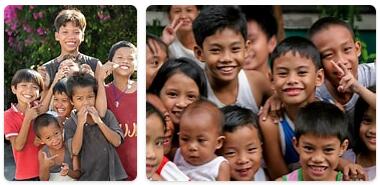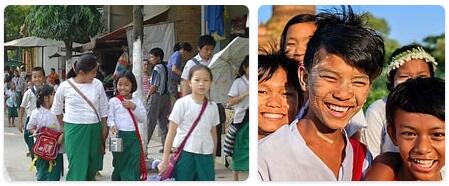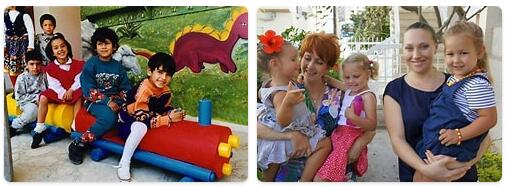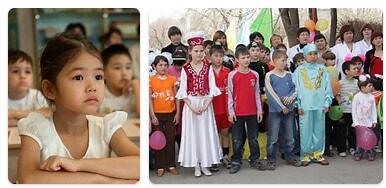Philippines 2014
Yearbook 2014
Philippines. In January, the Muslim guerrilla MILF (Moro’s Islamic Liberation Front) and the government signed a disarmament agreement in exchange for Muslim autonomy on parts of the island of Mindanao in the south. The new region, called Bangsamoro, is scheduled to be set up within a couple of years. The settlement constituted a fourth partial agreement in the negotiations that were held for a couple of years during mediation by Malaysia and was seen as an important step in the peace process.
Economy
| Inflation rate | 2.90% |
| Unemployment rate | 5.7% |
| Gross domestic product (GDP) | 877,200,000,000 USD |
| GDP growth rate | 6.70% |
| GDP per capita | $ 8,400 |
| GDP by sector | |
| Agriculture | 9.60% |
| Industry | 30.60% |
| Service | 59.80% |
| State budget | |
| Revenue | 19.07 billion |
| Expenditure | 20.29 billion |
| Proportion of the population below the national poverty line | 26.5% |
| Distribution of household income | |
| Top 10% | 33.6 |
| Lower 10% | 2.6 |
| Industrial production growth rate | 6.80% |
| Investment volume | 14.3% of GDP |
| National debt | 39.90% of GDP |
| Foreign exchange reserves | $ 81,530,000,000 |
| Tourism | 2014 |
| Number of visitors | 4,833,000 |
| Revenue | $ 6,052,000,000 |
A guerrilla outbreak group, BIFF (Bangsamoro’s Islamic Freedom Fighters), opposed the agreement and, at the end of the month, hit with the army, with some 40 dead rebels as a result.
In March, however, the government and the MILF were able to sign what was termed a historic peace treaty in Manila, after years of negotiations and several decades of fighting that claimed around 120,000 lives. The agreement meant that the largest armed group in Southeast Asia, with at least 10,000 warring members, committed to laying down arms and renouncing terrorist acts. Apart from BIFF, there were also several other small Muslim guerrilla groups that were not covered by the peace agreement and who promised continued struggle for their own state.
Philippines population in 2020 is estimated at 109,581,089. President Benigno Aquino hoped to complete the peace process with the MILF before the end of his term of office in 2016. Later, during the year, he declared support for a regional parliament in Bangsamoro and that Islamic Sharia law should apply to Muslims in the area. The UN called the proposal a milestone on the road to peace.

In June, three senators were arrested on suspicion of an extensive corruption scandal revealed in the previous year. The scandal involved a fund from which all members of Congress received funding to invest in local development projects. According to the disclosure, many of them had instead put millions of dollars into their own pockets. Among the arrested senators was a son of former President Joseph Estrada and a 90-year-old senator who was Minister of Defense under dictator Ferdinand Marcos in the 1980s.
Following the disclosure, Aquino abolished the fund as part of its fight against corruption. The efforts to fight corruption seemed to pay dividends. In 2013, the Philippines ranked 94th out of 177 countries in Transparency International’s corruption index, compared to 129th place two years earlier. The president also enjoyed strong voter support; over 70 percent of voters said they were happy with him.
On the anniversary of typhoon Haiyan’s ravages in November, thousands of people gathered with candles and white balloons around the town of Tacloban on the island of Leyte to honor the memory of the over 6,000 dead. Some people still lived in tented camps a year after the disaster, but to a large extent new homes had been built and trade, school, healthcare and water supply had started.
In December, nearly a million people left their homes as the typhoon Hagupit approached, but the damage was less severe than expected.
Manila – skyscrapers, slums, churches, carpools
According to topb2bwebsites, the metropolis of Manila, with more than 12 million inhabitants – a whole born of 17 districts and suburbs – is a mind-boggling mix of old and new, extreme wealth and immense poverty. History is reflected in buildings and multicultural multitude. The Spanish colonial hosts brought their architecture when they came. To the south of the Pasigjoki district, the Intramuros district dates back to the days of the Spanish conquest. Admittedly, Baroque-style churches and fortresses suffered severe damage during the World War II bombings. Makati, with its skyscrapers and shopping malls, is the economic center of the country. The administration buildings are located in the northeast of Quezon. Most hotels and popular tourist areas with their museums and boutiques can be found on the shores of the Gulf of Manila in Ermita and Malate.
Rizal Park, better known as Lunetana, is the city’s green lungs. To the north are large parts of China, known for their narrow shopping streets, but also for their numerous Baroque-style churches. The most famous of these is the Church of the Black Nazarene. Its saint is followed every January by one of the greatest crucifixions in the world.
The emblem of Manila is a jeepney, a scheduled taxi that takes care of public transport. These originally American military SUVs, a jeep and bus intersection, only leave the stop when the car is full of crowds. Painted in variegated and decorated with tassels, bells and protective amulets, more than 60,000 jeeps hit and rumble through the streets of Manila.


